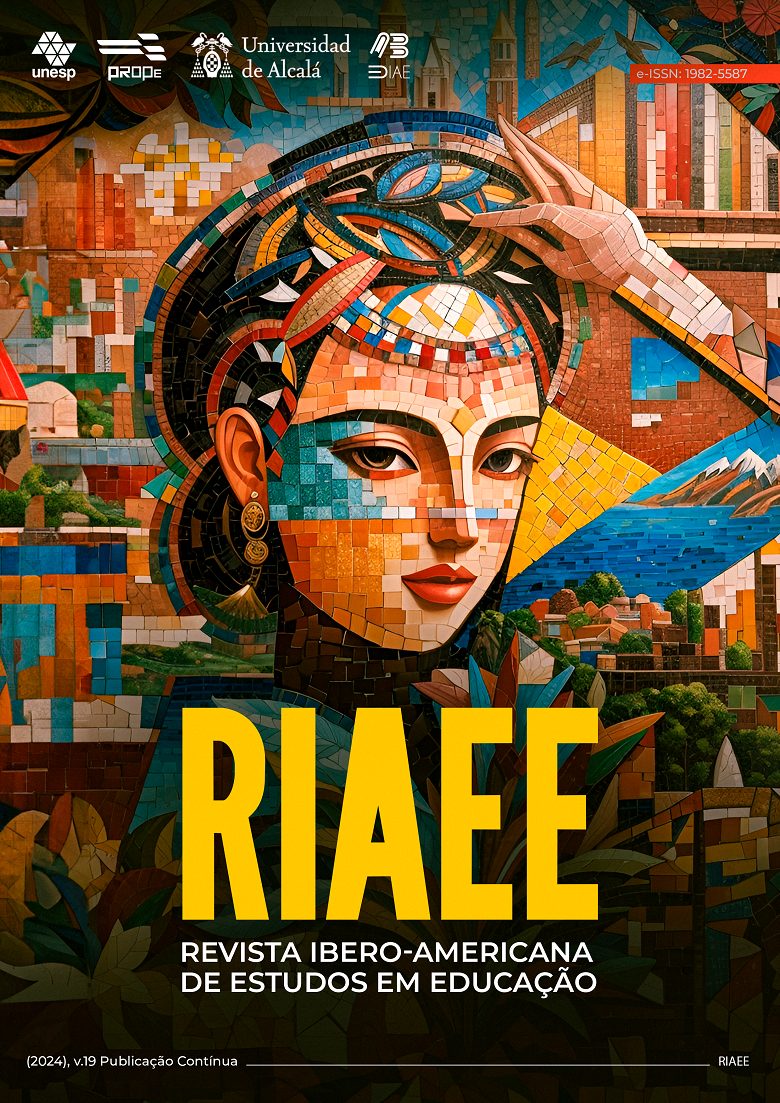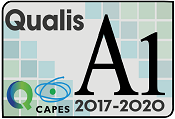UMA ABORDAGEM PARA O AVANÇO DE FERRAMENTAS BASEADAS NA INTELIGÊNCIA ARTIFICIAL GERATIVA PARA AVALIAÇÃO LINGUÍSTICA DE LÍNGUAS: UMA ANÁLISE SWOT
DOI:
https://doi.org/10.21723/riaee.v19i00.19060Palavras-chave:
Inteligência artificial generativa, Avaliação, Competências, Aprendizado de segunda línguaResumo
Este artigo analisa a integração da Inteligência Artificial (IA) Generativa na avaliação linguística de idiomas. Utilizando uma abordagem mista, revisa-se a literatura especializada e coletam-se dados por meio de pesquisas e entrevistas com profissionais da educação, para compreender as tendências e desafios dessas ferramentas. Os resultados indicam que, embora as aplicações de IA sejam eficientes e adaptáveis às necessidades individuais, enfrentam desafios significativos, incluindo questões éticas e resistência à mudança por parte de professores e estudantes. Finalmente, conclui-se a necessidade de um planejamento estratégico e cuidadoso para incorporar eficazmente a IA na educação linguística, melhorando as metodologias de ensino e avaliação.
Downloads
Referências
BLAKE, R. J.; GUILLÉN G.; THORNE S. L. Brave New Digital Classroom: Technology and Foreign Language Learning. Georgetown University Press, 2020. DOI: 10.2307/j.ctv1nc6rkf.
BLIKSTEIN, P. Multimodal learning analytics. In: INTERNATIONAL CONFERENCE ON LEARNING ANALYTICS AND KNOWLEDGE, 3., 2013. Proceedings […]. [S. l.: s. n.], 2013. DOI:10.1145/2460296.2460316.
BONAMI, B.; PIAZENTINI, L.; DALA-POSSA, A. Education, big data and artificial intelligence: Mixed methods in digital platforms. COMUNICAR: Media Education Research Journal, [S.I], v. 28, n. 65, p. 43-51, 2020. Disponible en: https://www.proquest.com/scholarly-journals/education-big-data-artificial-intelligence-mixed/docview/2488221174/se-2. Acceso: 14 nov. 2023.
BRYANT, P.; COOMBS, A.; PAZIO, M.; WALKER, S. Disruption, destruction, construction or transformation? The challenges of implementing a university wide strategic approach to connecting in an open world. 2014. Disponible em: http://eprints.lse.ac.uk/56577. Acceso: 14 nov. 2023.
CHAPELLE, C. A.; VOSS, E. 20 years of technology and language assessment in Language Learning & Technology. Language Learning & Technology, [S.I], v. 20, n. 2, p. 116-128, 2016. Disponible en: http://llt.msu.edu/issues/june2016/chapellevoss.pdf. Acceso: 14 nov. 2023.
CONSEJO DE EUROPA. Marco Común Europeo de Referencia para las Lenguas: aprendizaje, enseñanza, evaluación. 2020. Disponible en: https://rm.coe.int/common-european-framework-of-reference-for-languages-learning-teaching/16809ea0d4. Acceso: 14 nov. 2023.
CORNILLIE, F.; THORNE, S. L.; DESMET, P. ReCALL special issue: Digital games for language learning: challenges and opportunities: Editorial Digital games for language learning: from hype to insight? ReCALL., [S.I], v. 24, n. 3 p.243-256, 2012. DOI: 10.1017/S0958344012000134.
DUOLINGO. 2023. Disponible en: https://es.duolingo.com. Acceso: 14 nov. 2023.
ESCOBAR HERNÁNDEZ, J. C. La Inteligencia Artificial y la Enseñanza de lenguas. Una aproximación al tema. Revista del Centro de Enseñanza para Extranjeros, [S.I], v. 21 n. 25, p. 29-44, 2021. DOI:10.22201/cepe.14059134e.2021.21.25.3.
GILMORE, A. Authentic materials and authenticity in foreign language learning. Language Teaching, [S.I], v. 40, n. 2, p. 97-118, 2007. DOI:10.1017/S0261444807004144.
GRIFFITHS, C.; TAGG, C. The effects of a digital intervention on ESL learners' general English proficiency. Language Learning & Technology, [S.I], v. 22, n. 1, p. 1-20, 2018.
GUTHRIE, J. T.; WIGFIELD, A. Engagement and motivation in reading. In: KAMIL, M. L.; MOSENTHAL, P. B.; PEARSON, P. D.; BARR, R. (ed.). Handbook of reading research. Mahwah: Erlbaum, 2000.
HAMPEL, R.; STICKLER, U. New skills for new classrooms: Training tutors to teach languages online. Computer Assisted Language Learning, [S.I], v. 18, n. 4, p. 311-326, 2005. DOI:10.1080/09588220500335455.
HEIFT, T.; SCHULZE, M. Errors and intelligence in computer-assisted language learning: Parsers and pedagogues. New York: Routledge, 2007.
HELMS, M. M.; NIXON, J. Exploring SWOT analysis – where are we now? A review of academic research from the last decade. Journal of Strategy and Management, [S.I], v. 3 n. 3 p. 215-251, 2010. DOI:10.1108/17554251011064837.
JOHNSON, M.; GRIFFITHS, M.; WANG, Y. Artificial intelligence in education: Challenges and opportunities for sustainable development. UNESCO Working Papers on Education Policy, [S.I], n. 7, 2020. Disponible en: https://unesdoc.unesco.org/ark:/48223/pf0000366994.locale=es. Acceso: 14 nov. 2023.
KORMOS, J.; DÉNES, M. Exploring measures and perceptions of fluency in the speech of second language learners. System, [S.I], v. 32, n. 2, p. 145-164, 2004. DOI: 10.1016/j.system.2004.01.001
KRAMSCH, C. Context and culture in language teaching. Oxford: Oxford University Press, 1993.
LAHZA, H.; KHOSRAVI, H.; DEMARTINI, G. Analytics of learning tactics and strategies in an online learner sourcing environment. Journal of Computer Assisted Learning, [S.I], v. 39, n. 1, p. 94-112, 2023. DOI:10.1111/jcal.12729.
LEE, J. J.; HAMMER, J. Gamification in education: What, how, why bother? Academic Exchange Quarterly, [S.I], v. 15, n. 2, 2011.
LEVY, M.; STOCKWELL, G. Call dimensions: Options and issues in computer-assisted language learning. Mahwah: Lawrence Erlbaum, 2006.
MAGAL-ROYO, T.; GARCÍA LABORDA, J. Una aproximación del efecto en el aprendizaje de una lengua extranjera debida a la obtención de datos a través de exámenes en línea de idiomas. RED. Revista de Educación a Distancia, [S.I], v. 53, p. 1-14, 2017. Disponible en: https://revistas.um.es/red/article/view/289881. Acceso: 14 nov. 2023.
MAGAL-ROYO, T.; GARCÍA LABORDA, J. Standardization of design interfaces applied to language test on-line through ubiquitous devices. International Journal of Interactive Mobile Technologies (iJIM), [S.I], v. 12, n. 4, p. 21-31, 2018. DOI:10.3991/ijim.v12i4.9197.
MAYER, R. E. Multimedia learning. Cambridge: Cambridge University Press, 2001. DOI:10.1017/CBO9781139164603.
NERI, A.; CUCCHIARINI, C.; STRIK, H.; BOVES, L. The pedagogy-technology interface in Computer Assisted Pronunciation Training. Computer Assisted Language Learning, [S.I], v. 15, n. 5, p. 441-467, 2002. DOI:10.1076/call.15.5.441.13473
O'DOWD, R. Telecollaboration and the development of intercultural communicative competence. Munich: Langenscheidt-Longman, 2006. ISBN: 9783526508359.
O'SHEA, K.; BANDAR, Z.; CROCKETT, K. A survey of chatbot systems through a Loebner prize competition. Artificial Intelligence Review, [S.I], v. 53, n. 8, p. 5613-5649, 2020. DOI:10.1007/s10462-020-09870-7.
OUYANG, F.; WU, M.; ZHENG, L.; ZHANG, L.; JIAO, P. Integration of artificial intelligence performance prediction and learning analytics to improve student learning in online engineering course. International Journal of Educational Technology in Higher Education, [S.I], v. 20, n. 4, 2023. DOI:10.1186/s41239-022-00372-4.
PDFGEAR, COM. Intelectualizar y chatear archivos PDF con Asistente de IA. Disponible en: https://www.pdfgear.com. Acceso: 14 nov. 2023.
QUIZLET.COM. Quizlet/Q-Chat. Disponible en: https://quizlet.com. Acceso: 14 nov. 2023.
SONDEREGGER, S. How generative language models can enhance interactive learning with social robots. In: INTERNATIONAL CONFERENCE ON COGNITION AND EXPLORATORY LEARNING IN DIGITAL AGE, 19., 2022. Proceedings […]. [S. l.: s. n.], 2022. ISBN: 978-989-8704-43-6.
STORCH, N. Collaborative writing: Product, process, and students’ reflections. Journal of Second Language Writing, [S.I], v. 14, n. 3, p. 153-173, 2005.
VASWANI, A.; SHAZEER, N.; PARMAR, N.; USZKOREIT, J.; JONES, L.; GOMEZ, A. N.; KAISER, L.; POLOSUKHIN, I. Attention is all you need. Advances in Neural Information Processing Systems, [S.I], v. 30, 2017, p. 5998-6008. ISBN: 9781510860964. Disponible en: https://arxiv.org/abs/1706.03762. Acceso: 14 nov. 2023.
WARSCHAUER, M.; HEALEY, D. Computers and language learning: An overview. Language Teaching, [S.I], v. 31, n. 2, p. 57-71, 1998.
WARSCHAUER, M. Invited commentary: New tools for teaching writing. Language Learning & Technology, [S.I], v. 14, n. 1, p. 3-8, 2010. Disponible en: http://llt.msu.edu/vol14num1/commentary.pdf. Acceso: 14 nov. 2023.
WRITEMAGE. Disponible en: https://writemage.com/. Acceso: 14 nov. 2023.
XU, J .; PENG, H. Investigating mobile-assisted oral feedback in teaching Chinese as a second language. Computer Assisted Language Learning, [S.I], v. 30, n. 3-4, p. 173-182, 2017.
ZAWACKI-RICHTER, O .; MARÍN, V. I .; BOND, M .; GOVERNEUR, F. Systematic review of research on artificial intelligence applications in higher education - where are the educators? International Journal of Educational Technology in Higher Education, [S.I], v. 16, n. 1, p. 1-27, 2019. DOI: 10.1186/s41239-019-0171-0.
Downloads
Publicado
Como Citar
Edição
Seção
Licença
Copyright (c) 2024 Jesús García Laborda, Teresa Magal-Royo, Miguel Fernández Álvarez

Este trabalho está licenciado sob uma licença Creative Commons Attribution 4.0 International License.
Manuscritos aceitos e publicados são de propriedade dos autores com gestão da Ibero-American Journal of Studies in Education. É proibida a submissão total ou parcial do manuscrito a qualquer outro periódico. A responsabilidade pelo conteúdo dos artigos é exclusiva dos autores. A tradução para outro idioma é proibida sem a permissão por escrito do Editor ouvido pelo Comitê Editorial Científico.








